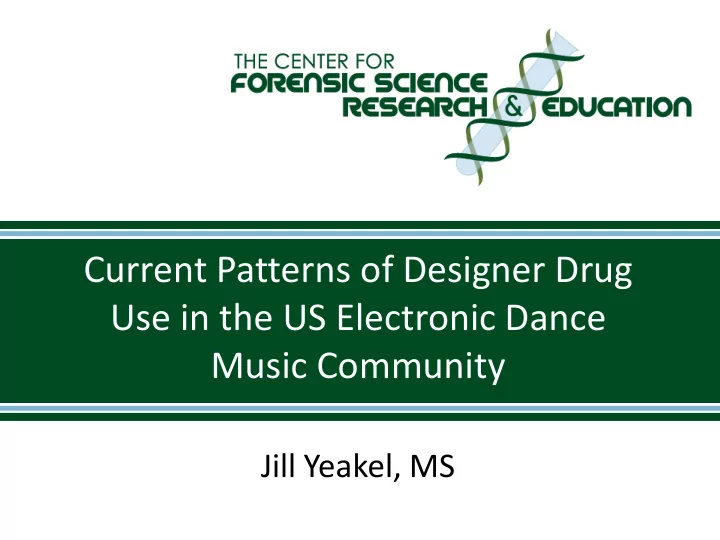

Current Patterns of Designer Drug Use in the US Electronic Dance Music Community Jill Yeakel, MS
Disclaimer The project was supported by Award No. 2013- DN-BX-K018, awarded by the National Institute of Justice, Office of Justice Programs, U.S. Department of Justice. The opinions, findings, and conclusions or recommendations expressed in this publication/program/exhibition are those of the author(s) and do not necessarily reflect those of the Department of Justice.
Designer Drugs: Recent History • 2009-2010: Evidence of synthetic cathinone abuse in European countries and US • October 2011: US DEA emergency scheduled MDPV, Mephedrone, Methylone – Signed into law June 2012 for MDPV, Mephedrone
Project Background • Designer drugs: unregulated psychoactive constituents (phenethylamines, cathinones, synthetic cannabinoids) • Increased in popularity recently, especially prevalent at electronic dance music (EDM) festivals • Collect biological samples from EDM festival attendees
Project Objectives • Analyze samples to obtain information regarding: – New drugs on the market – Prevalence of designer drugs – Identification of novel designer drugs and metabolites – Correlations and comparisons of designer drugs in blood, urine and oral fluid specimens
Verbal Recruitment • Approached possible participants on their way to the EDM festival • Recruiters provided possible volunteers with brief overview of goals and requirements • Recruiting Tactics – Public Health Aspect – Harm Reduction – Incentives – “Helping Science”
Sample Collection Location • Location was ~100 yards from the entrance gate
Sample Collection • Step 1: Consent forms/Survey • Step 2: Oral Fluid Collection – Quantisal – Alere DDS2 Cartridge • Step 3: Urine • Step 4: Blood Disclosure: Participants were not required to donate all 4 samples, and only donated samples based on their comfort level. The gift card incentive was only given if the participant donated a blood sample.
Participant Attire
Participant Demographics • Total number of participants: 145 • Average age of participants: 24 • Females: 60 • Males: 74 • Admitted to drug use in past week: 103 (71%) • Total number of urine samples collected: 104
Urine Results • Samples underwent a battery of screen and confirmation tests: – Immunoassay – Volatiles – RapidFire-MS/MS – GC/MS – LC-QTOF – LC-MS/MS
Immunoassay Kit # Positives # Confirm Positive % Positive MDMA 8 8 7.7 Cocaine 17 17 16.3 Oxycodone 2 2 1.9 Amphetamines 11 11 (6) 10.6 THC 53 53 51.0 Methamphetamine 11 9 (6, 2) 8.7 Benzodiazepines 6 2 1.9 PCP 3 0 0 • All negative: LSD, Opiates, 6AM, Barbiturates, K2
Volatiles Analyte # Positives % Positive Alcohol 29 27.9 Acetone 13 12.5 Alcohol + 1 Drug 11 10.6 Alcohol + Multiple Drugs 15 14.4
RapidFire MS/MS Analyte # Positive # Confirm Positives (>10) Methylone 16 19 a-PVP 5 13 Butylone/Ethylone 6 6 25I-NBOMe 1 0 a-PPP 6 0 JWH018-COOH 4 0 JWH073-COOH 2 0
GC/MS Results Result # GC/MS + # Confirm + % of Total Positivity Rate 68 189 36.0 (# Positives/Total # Positives) Confirmation Rate 68 98 69.4 (# Screen Positives/# Confirm Positives)
LC-QTOF Results Result # LC-QTOF + # Confirm + % of Total Positivity Rate 106 189 55.6 (# Positives/Total # Positives) Confirmation Rate 106 109 97.2 (# Screen Positives/# Confirm Positives)
Drug Testing Results Screen vs. Confirm 60 50 40 30 20 Screen Confirmation 10 0
% Confirmation Rate 100.0 80.0 60.0 40.0 20.0 0.0
% Positive Rate 60.0 50.0 40.0 30.0 20.0 10.0 0.0
Drug Results “Class” Analyte # Positives Alprazolam/a-OH 2 Benzodiazepines Oxazepam 1 Amphetamine 7 Methamphetamine 5 Amines MDA 11 MDMA 9 Benzoylecgonine 29 Cocaine Cocaine 14 Cocaethylene 6 Tramadol 3 Methadone/EDDP 1 Opiates Oxycodone 3 Oxymorphone 2 Buprenorphine/Nor 1
Drug Results ctnd. “Class” Analyte # Positives Methylone 23 Butylone 9 Ethylone 6 4-FA 4 Designers a-PVP 13 Dimethylone 10 5-APB 1 2-CB 1 Bupropion 1 Dextromethorphan 6 Cyclobenzaprine 1 Fluoxetine 3 Other Compounds Methylphenidate 1 DMAA 1 Psilocin 1 Dehydronorketamine/Nor 2 Azacyclonal 1
Result Dispersion % 15.4 16.3 Negative Alcohol Only 7.7 Single Drug Positive 1 Drug + Alcohol Multiple Drug Positive 34.6 21.2 Multiple Drugs + Alcohol 4.8
Drug Popularity • Most commonly encountered compounds: – THC (51.0%) – Alcohol (27.9%) – Cocaine (23.1%) – Methylone (22.1%) • Most common combinations: – Cocaine/THC (18.3%) – Methylone/THC (14.4%) – Methylone/Cocaine (13.5%) – Methylone/MDMA (5.8%)
Admissions vs. Results • Most commonly admitted to compounds: – THC (40.0%) – Actual positives = 51% – Alcohol (18.0%) – Actual positives = 27.9% – Cocaine (12.4%) – Actual positives = 23.1% – Ecstasy/MDMA (12.4%) – Actual positives = 12.5% – Molly (10.3%) – Actual positives = 22.1% (Methylone) • Note: All admissions were for recreational drugs or medications ingested over the past week
Thank You • Thank you to everyone involved in the grant for you participation and help Melissa Friscia, Mandi Mohr, Dr. Barry Logan,
Thank You • Thank you to everyone at AFMES for helping with all the aliquoting, extractions, data analysis, etc. Aliquoting – Alex Layne, Lauryne Gauthier Volatiles – HM2 Huseman, Amber Dickson Immunoassay/GC/MS Base Screen – Garland Hayward LC-QTOF Screen – John Kristofic Quants – Joseph Addison, Sarah Shoemaker, Jessica Knittel, Jeff Chmiel RapidFire – Dr. Arianne Motter, Jillian Neifeld Synthetic Cannabinoids – Dona’Rae Boucek, Lauryne Gauthier Project Coordination – CDR Bosy, Joseph Magluilo, Shawn Vorce, Justin Holler
Questions?
Recommend
More recommend